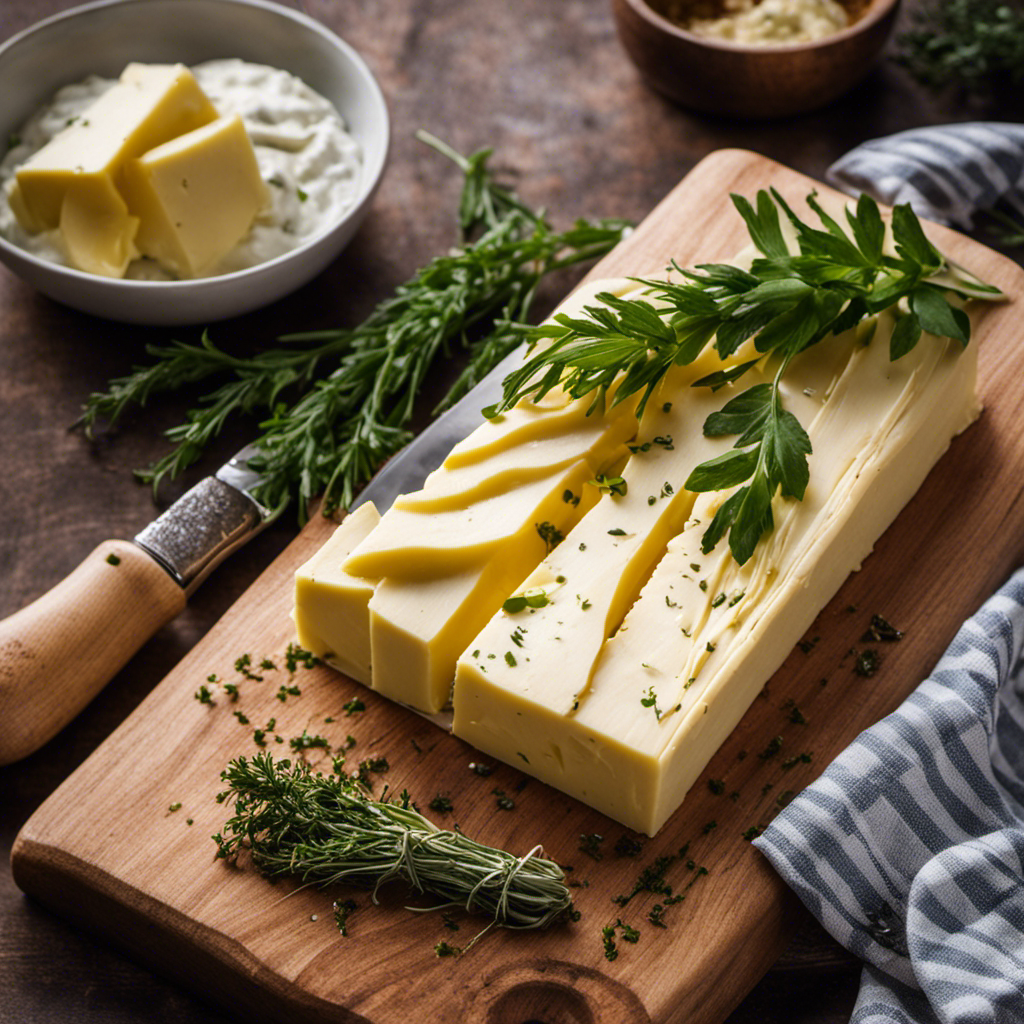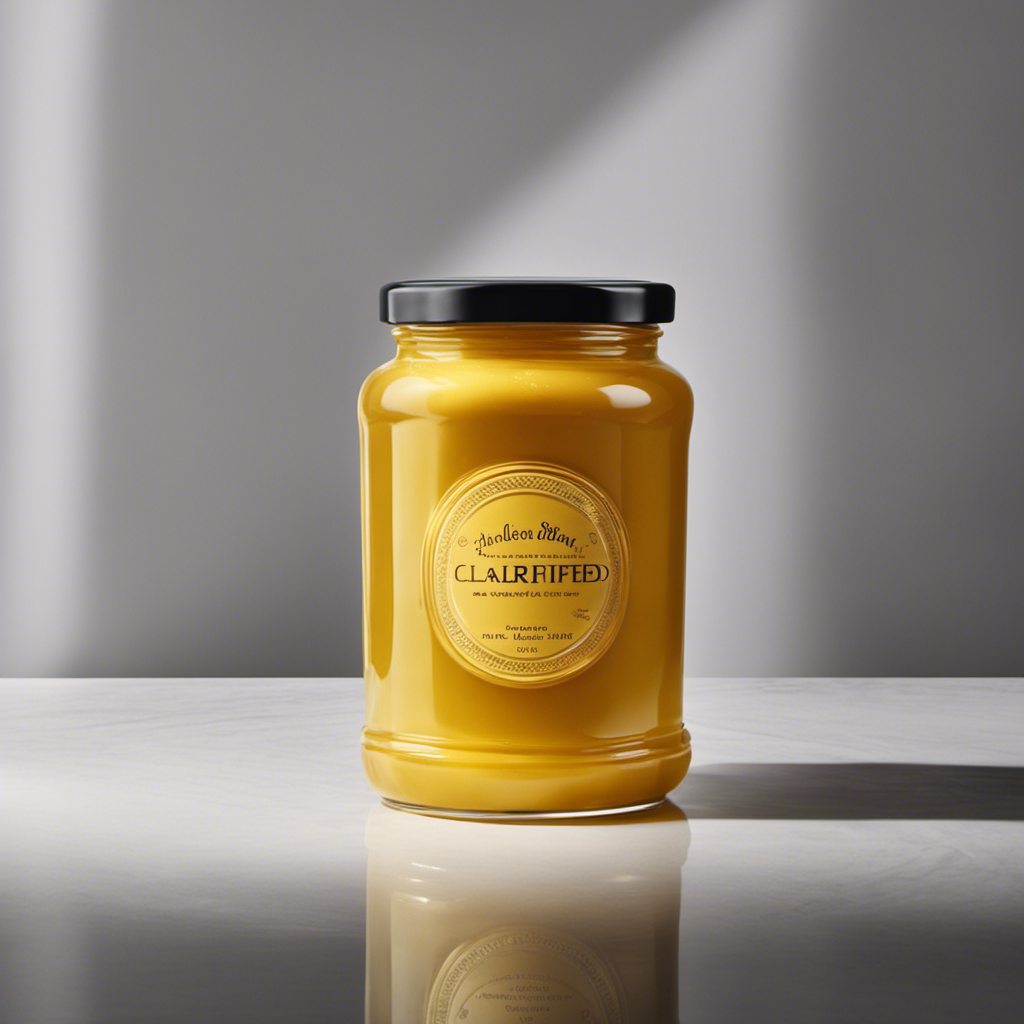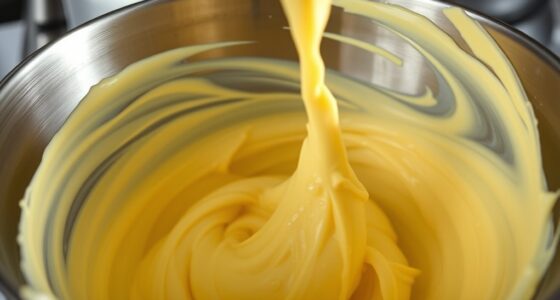Who can resist a flawlessly seasoned compound butter? It introduces an explosion of taste to every meal, rendering it utterly compelling.
But have you ever wondered how long this culinary gem can last? Well, fear not, because I’ve got all the answers for you. In this article, I’ll dive into the shelf life of compound butter, the factors that affect its longevity, proper storage techniques, and even how to spot signs of spoilage.
So sit tight and get ready to become a compound butter expert!
Key Takeaways
- Compound butter can last up to two weeks in the refrigerator.
- Freezing can extend shelf life for several months.
- Proper storage conditions include using an airtight container or plastic wrap.
- Quality of ingredients affects freshness.
Shelf Life of Compound Butter
Compound butter can last for up to two weeks in the refrigerator, but you should check for any signs of spoilage before using it.
It’s important to store compound butter in an airtight container to prevent it from absorbing any odors or flavors from other foods in the fridge.
If you want to extend its shelf life, you can also freeze compound butter. Simply wrap it tightly in plastic wrap or place it in a freezer-safe container. Frozen compound butter can last for several months.
When using compound butter in recipes, it adds a burst of flavor and richness. It can be used to enhance the taste of grilled meats, roasted vegetables, or even spread on freshly baked bread.
It’s a versatile ingredient that can take your dishes to the next level.
Factors Affecting the Longevity of Compound Butter
Factors like temperature and storage conditions can impact how long compound butter remains fresh. When it comes to freshness, there are several key factors to consider. First, temperature plays a crucial role. Keeping compound butter at a temperature below 40°F (4°C) helps prevent bacterial growth and extends its shelf life. Secondly, proper storage conditions are essential. Storing compound butter in an airtight container or wrapping it tightly in plastic wrap helps prevent exposure to air and moisture, which can lead to spoilage. Lastly, the quality of the ingredients used in the compound butter can also affect its freshness. Using fresh, high-quality butter and herbs ensures a longer shelf life. By considering these factors and storing compound butter properly, you can maximize its freshness and enjoy its delicious flavors for longer.
| Factors Affecting Freshness | Proper Storage Conditions | Quality of Ingredients |
|---|---|---|
| Temperature below 40°F | Airtight container or plastic wrap | Fresh, high-quality butter and herbs |
Proper Storage Techniques for Compound Butter
As someone who enjoys using compound butter in my cooking, it’s important to understand how to properly store it to ensure its longevity and maintain its quality.
In this discussion, I will cover some shelf life tips and safe storage methods for compound butter.
Shelf Life Tips
Remember to store your compound butter in an airtight container in the refrigerator to prolong its shelf life. Shelf life preservation is important to ensure that your compound butter remains safe to consume for as long as possible.
When stored properly, compound butter can last for up to three months in the refrigerator. It is crucial to keep it in an airtight container to prevent the absorption of odors and flavors from other foods in the fridge. Additionally, make sure to label the container with the date of preparation to keep track of its freshness.
Proper storage techniques will help maintain the quality and flavor of your compound butter, allowing you to enjoy it for an extended period. Now let’s explore safe storage methods to further ensure the longevity of your compound butter.
Safe Storage Methods
To maintain the quality and flavor of your compound butter, it’s important to store it in an airtight container in the refrigerator. Proper storage is crucial for safe handling and to prevent spoilage. Here are some recommended containers and storage methods to ensure the longevity of your compound butter:
-
Glass jars with tight-fitting lids: These containers are ideal for storing compound butter as they are airtight and won’t absorb odors or flavors from other foods in the refrigerator.
-
Plastic containers with snap-on lids: Choose containers made of food-grade plastic that are BPA-free and have airtight seals. These containers are lightweight and easy to stack, making them convenient for storing compound butter.
-
Silicone molds: If you prefer individual portions of compound butter, silicone molds are a great option. They are flexible, making it easy to remove the butter, and can be stacked in the refrigerator.
-
Vacuum-sealed bags: Vacuum-sealing your compound butter removes air, preventing oxidation and prolonging its shelf life. These bags are also space-saving and can be stored flat in the refrigerator.
Signs of Spoilage in Compound Butter
When it comes to compound butter, it’s important to be able to identify signs of spoilage. Mold or discoloration is a clear indication that the butter has gone bad and should not be consumed.
Additionally, if the butter has an off smell or taste, it is best to discard it to avoid any potential health risks.
Lastly, it is essential to follow the expiry date guidelines provided on the packaging to ensure the freshness and quality of the compound butter.
Mold or Discoloration
If stored properly, compound butter typically won’t develop mold or discoloration. Here are some tips to prevent these issues:
-
Keep it sealed: Store compound butter in an airtight container or wrap it tightly in plastic wrap to prevent air exposure, which can lead to mold growth.
-
Use fresh ingredients: Ensure that the herbs, spices, and other flavorings used in the compound butter are fresh and free from any signs of spoilage. This will help prevent any mold or discoloration from occurring.
-
Store in the refrigerator: Compound butter should always be stored in the refrigerator to maintain its freshness and prevent the growth of mold or bacteria.
-
Use within the recommended time: While compound butter can last for several weeks in the refrigerator, it is best to use it within 2-3 weeks to prevent any potential mold or discoloration.
Off Smell or Taste
If you notice an off smell or taste in your compound butter, it is best to discard it to avoid any potential health risks. Off smells or taste changes can be indicators of spoilage or bacterial growth in the butter. It is important to remember that compound butter is made by mixing butter with various ingredients, such as herbs or spices, and these additional components can also go bad over time. When the butter starts to develop an unpleasant odor or taste, it is a sign that it has gone bad.
Consuming spoiled compound butter can lead to foodborne illnesses, so it is crucial to be cautious. It is always better to be safe than sorry when it comes to your health. So, if you notice any off smells or taste changes, it is recommended to discard the compound butter immediately.
Now, let’s dive into the next section about expiry date guidelines.
Expiry Date Guidelines?
To determine the expiration date of your compound butter, check the label or packaging for guidelines. Here are some general expiry date recommendations and best practices for storing compound butter:
-
Store in the refrigerator: Compound butter should always be stored in the refrigerator to maintain its freshness and prevent the growth of harmful bacteria.
-
Use within 1-2 weeks: It is generally recommended to use compound butter within 1-2 weeks of its production date. This ensures the best flavor and quality.
-
Check for signs of spoilage: Before using compound butter, always check for any signs of spoilage, such as an off smell or mold. If you notice any of these signs, it’s best to discard the butter.
-
Follow proper handling practices: When using compound butter, make sure to use clean utensils or hands to prevent contamination.
By following these expiry date recommendations and best practices, you can ensure that your compound butter stays fresh and delicious.
Now, let’s explore how to extend the lifespan of compound butter.
Extending the Lifespan of Compound Butter
You can extend the lifespan of compound butter by storing it properly in the refrigerator. This will help in extending the freshness and preserving the flavor of the butter for a longer period of time. By following some simple guidelines, you can ensure that your compound butter remains in its best condition. Here are some tips for storing compound butter in the refrigerator:
| Temperature | Time |
|---|---|
| 32°F | 1-2 weeks |
| 40°F | 1 week |
| 45°F | 3-5 days |
| 50°F | 2-3 days |
It’s important to note that these are general guidelines and the exact lifespan may vary depending on the ingredients used and storage conditions. However, by keeping your compound butter at a consistent and cool temperature, you can maximize its shelf life. Now, let’s explore the pros and cons of freezing compound butter.
Freezing Compound Butter: Pros and Cons
When freezing compound butter, it’s essential to consider the pros and cons. Freezing can be a great way to extend the lifespan of your compound butter and ensure that it stays fresh for longer periods.
Here are some pros of freezing compound butter:
- Preserves freshness: Freezing helps to maintain the flavor and quality of the compound butter.
- Convenient storage: You can freeze compound butter in individual portions, making it easy to use whenever needed.
- Versatility: Frozen compound butter can be used in various dishes, from spreading on bread to enhancing the flavor of cooked meats.
- Time-saving: By freezing compound butter, you can always have it on hand, eliminating the need for last-minute preparation.
On the other hand, there are also some cons of freezing compound butter:
- Texture changes: Freezing and thawing can sometimes alter the texture of the compound butter, making it slightly grainy.
- Loss of some flavor: Despite efforts to preserve the taste, freezing can cause a slight loss of flavor in the compound butter.
- Limited storage time: While frozen compound butter can last for several months, it is recommended to use it within six months for optimal quality.
- Thawing process: Proper thawing is crucial to maintain the integrity of the compound butter and prevent any potential spoilage.
Using Leftover Compound Butter
If you have any leftover compound butter, there are plenty of creative ways to use it in your cooking.
One of my favorite ways to incorporate leftover compound butter is in baking. It adds a rich, flavorful twist to baked goods like bread, muffins, and even cookies. Simply substitute some of the regular butter or oil in your recipe with the compound butter for an extra burst of flavor.
Another great use for leftover compound butter is to spread it on toast or warm bread for a delicious and savory treat.
You can also melt it and drizzle it over grilled vegetables or steamed seafood for a tasty finishing touch.
Don’t let that leftover compound butter go to waste, get creative and experiment with different recipes to enjoy its flavors in new and exciting ways.
Common Misconceptions About Compound Butter Expiration
When it comes to compound butter, there are some common misconceptions about its expiration. Let’s clear things up and learn about the best storage techniques to keep your compound butter fresh and safe to consume.
-
Misconception: Compound butter lasts forever.
- Reality: While compound butter has a longer shelf life than regular butter, it does have an expiration date.
-
Misconception: Compound butter cannot be frozen.
- Reality: Compound butter can be frozen for up to six months, which extends its shelf life significantly.
-
Misconception: Leaving compound butter at room temperature is safe.
- Reality: Compound butter should be stored in the refrigerator to prevent the growth of bacteria.
-
Misconception: Mold on compound butter is harmless.
- Reality: If you see mold on compound butter, it is best to discard it. Mold can produce toxins that can make you sick.
To ensure the longevity of your compound butter, store it in an airtight container in the refrigerator and use it within two to three weeks.
Frequently Asked Questions
Can I Use Flavored Compound Butter in Baking Recipes?
Yes, flavored compound butter can be used in baking recipes. The pros include adding unique flavors and enhancing the taste of baked goods. However, it’s important to consider the cons, such as potential texture changes. Creative ways to use flavored compound butter in baking recipes include incorporating it into pie crusts or spreading it on top of bread before toasting.
Are There Any Health Risks Associated With Consuming Expired Compound Butter?
Expired compound butter can pose health risks. It’s important to consume it within the recommended timeframe to avoid bacterial growth. Remember, our health is a precious gift, and taking care of what we eat is essential.
Can I Reuse the Container That the Store-Bought Compound Butter Came in for Homemade Compound Butter?
Yes, you can reuse the container from store-bought compound butter for homemade compound butter. However, make sure to clean it thoroughly before using. Homemade compound butter can last for several weeks when stored properly.
Is It Safe to Leave Compound Butter at Room Temperature for a Short Period of Time?
Leaving compound butter out for a short period of time is generally safe, but it should not exceed 2 hours. After that, it is best to refrigerate it to ensure its freshness and extend its shelf life.
Can I Use Compound Butter on Grilled Vegetables or Meats?
Using compound butter in marinades adds flavor and richness to grilled vegetables and meats. The pros include enhanced taste and moisture retention, but the cons are the risk of flare-ups and potential for overpowering flavors.
Conclusion
In conclusion, compound butter can be a delicious and versatile addition to your culinary repertoire. However, it is important to understand its shelf life and proper storage techniques to ensure its freshness and safety.
By following the guidelines discussed, you can extend the lifespan of your compound butter and avoid any potential spoilage. So, next time you make a batch of compound butter, remember to properly store it and enjoy its flavorful benefits for as long as possible.
Now go forth and conquer the kitchen with your newfound compound butter knowledge!










